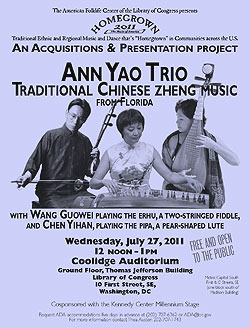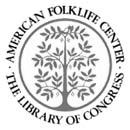| |
|||
|
The American Folklife Center at the Library of Congress presentsThe Homegrown 2011 Concert Series
|

|
Ann Yao gracefully embodies elements of China's musical past and present. Born into a family of musicians in Shanghai in 1960, a half-decade before Mao Zedong launched the Cultural Revolution, Ann grew up in her maternal grandparents' house surrounded by traditional Chinese musicians. By the age of nine, she was learning the pipa, a pear-shaped lute, from her grandfather, Sun Yu-de. He also played the xiao, a vertical bamboo flute. The influence of her aunt, Sun Wenyan, and her husband, He Baoquan, however, led her to begin playing the zheng, a five-foot-long zither, by the age of ten. In the decades since, Ann has grown from a child immersed in traditional music to a classically trained zheng musician who has played for state dignitaries in Beijing, at prestigious venues such as Carnegie Hall and Lincoln Center, and, most recently, in the China Pavilion at Disney's Epcot Center.
Regional musical traditions thrive throughout China. The Shanghai area is associated with an ensemble tradition known as Jiangnan sizhu. This largely improvisatory ensemble consists of the pipa, xiao, yangqin (hammered dulcimer), erhu (two-string fiddle), and dizi (horizontal bamboo flute). Jiangnan sizhu ensembles would travel, usually by foot or bus, to different houses, teahouses, and cultural centers in the Shanghai area, where they would give informal performances among friends. Ann's grandfather's house was an important community center for these ensembles. The house was also frequently filled with many music students, as well as theatrical artists, storytellers, and singers.
Jiangnan sizhu ensembles did not include the zheng due to its large size, which is not well suited for travel. Instead, the zheng has its own distinct traditions. The earliest references to the zheng in Chinese literature date to at least the third century B.C. During its long history, the number of strings on the instrument has varied. Ancient versions had only five strings; the standard size is now twenty-one strings. Ann also pioneered in experimenting with a "butterfly" zheng. Named for its butterfly-like shape, this forty-nine-string instrument combines two standard zhengs, and adds a few extra notes to each octave. Chinese instruments are divided into eight groups that correspond to the materials used in their construction. Like other stringed instruments, the zheng is classified as a "silk" instrument; in ancient times, the strings were made of silk. They are now made of metal and nylon.
As with other Chinese instruments, the zheng mainly provided entertainment and expressed personal emotions in ancient times. Beyond this common thread, different regional styles, or schools, exist; often, these schools are named for the provinces where they predominate. In several northern provinces - Henan, Shandong, and Shaanxi - the zheng primarily accompanied regional theatrical performances, whereas in the southern region, Zhejiang and Hakka zheng music was more for self-entertainment. Like her aunt and uncle, who were both exposed to a variety of regional schools, Ann's musical training and repertoire reflect a broad spectrum of styles. She was, however, particularly influenced by her aunt's training in the Zhejiang school, as well as the theatrical and folk styles she learned growing up at her grandfather's house in Shanghai.
In the second half of the twentieth century, Chinese music was increasingly influenced by Western music, as conservatory training became more widespread and a national music movement gained momentum. As a result, the zheng was featured more frequently as a concert solo instrument, with a greater emphasis placed on performance virtuosity and original compositions. It was also incorporated into Western-style orchestras. Ann had learned some Western music history and theory from the conservatory training, along with Western notation and sight singing, upon entering the Shanghai Conservatory of Music after high school. There she followed in her aunt's footsteps and joined the third generation of an ensemble that represented an emerging silk quintet tradition. While Jiangnan sizhu ensembles consist of silk and bamboo instruments, the quintet featured only silk instruments - the zheng, pipa, yangqin, ehru, and liuqin (a small, high-pitched lute). Ann first toured the United States with this group in 1982. Two years later, after she had graduated from the conservatory and joined Beijing's Central National Music Ensemble, she returned to the States to perform at the 1984 Olympic Arts Festival. Shortly thereafter, she moved to the United States permanently.
Ann's work with the innovative New-York-City-based ensemble Music from China most clearly illustrates her success fusing traditional and modern influences. The group consists of Chinese musicians who use traditional instruments to perform cutting-edge, contemporary compositions. As such, they preserve and promote traditional Chinese musical culture by presenting it in new compositional and performance contexts. While a regular member of this group in the late 1980s and early 1990s, Ann performed at Carnegie Hall, Lincoln Center, and the Metropolitan Museum of Art. Music from China also collaborated with celebrated cellist Yo-Yo Ma and composer Zhou Long for a performance at the Smithsonian that included two Chinese bells dating from between 1200 and 900 B.C.
For nearly twenty years, Ann has lived in Orlando, Florida, where she has performed at Disney's Epcot Center in the China Pavilion, among other venues. In 2009, the Florida Folklife Program recognized her with a Folk Heritage Award. Her dream is to return home one day to teach the zheng, like her family members before her, thereby ensuring that subsequent generations in China keep their traditional musical culture alive.
Blaine Waide
State Folklorist
Florida Folklife Program
 The American Folklife Center was created by Congress in 1976 and placed at the Library of Congress to "preserve and present American Folklife" through programs of research, documentation, archival preservation, reference service, live performance, exhibition, public programs, and training. The Center includes the American Folklife Center Archive of folk culture, which was established in 1928 and is now one of the largest collections of ethnographic material from the United States and around the world. Please visit our web site.
The American Folklife Center was created by Congress in 1976 and placed at the Library of Congress to "preserve and present American Folklife" through programs of research, documentation, archival preservation, reference service, live performance, exhibition, public programs, and training. The Center includes the American Folklife Center Archive of folk culture, which was established in 1928 and is now one of the largest collections of ethnographic material from the United States and around the world. Please visit our web site.
| ||||
